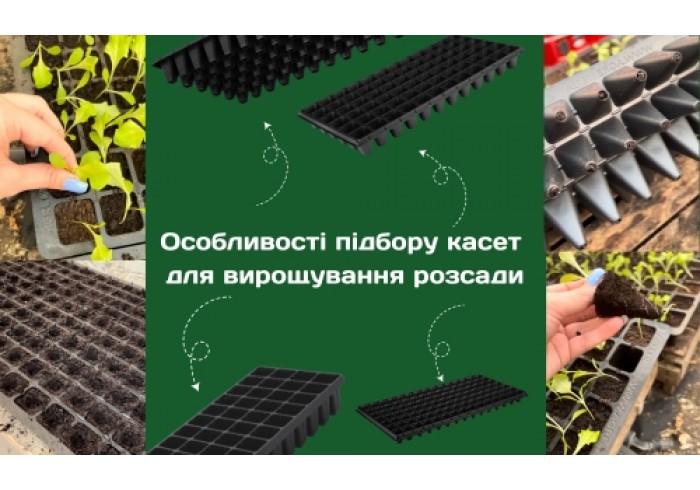Features of the selection of cassettes for growing seedlings
The tray method of seedling cultivation is a modern technology that allows optimizing the process of obtaining high-quality planting material. Proper selection of trays, taking into account the characteristics of the crop and growing conditions, is a key success factor. Despite some drawbacks and common stereotypes, the advantages of this technology make it a promising direction for both industrial and amateur horticulture. The main thing is to consider the specifics of each crop and follow the recommended agricultural practices.
Relevance of the tray method of seedling cultivation
In modern agriculture, the tray method of growing seedlings is gaining increasing popularity.
Buying seedling trays is worthwhile due to a number of significant advantages over alternatives:
- Production intensification. Tray technology makes it possible to grow a significantly larger number of plants in a limited space compared to traditional methods.
- Efficient space usage. Thanks to compact placement, trays save up to 30–40% of greenhouse and hotbed space.
- Resource saving. Using trays reduces the consumption of substrate, fertilizers, and water per unit of grown seedlings.
- Workflow optimization. Trays greatly simplify plant care and increase labor productivity.
- Reduced transplant stress. Each plant grows in an isolated cell, making it easy to remove from the container without damaging the roots and allowing quick adaptation after transplanting into the soil.
- Controlled growth conditions. Each plant receives optimal and identical conditions, resulting in high-quality, uniform seedlings.
Tray-based seedling cultivation: advantages and disadvantages
Agronomic advantages:
- Isolated root system. Each plant develops in a separate cell, promoting strong and well-branched root systems.
- Even feeding area. All plants receive the same growing area and conditions, ensuring uniform growth and development without competition.
- Even lighting. All plants receive equal light, preventing seedling stretching.
- Lower disease risk. Trays separate plants, reducing the spread of root rot and other diseases.
- Efficient watering. Moisture is evenly distributed across all cells without waterlogging.
- Ease of transplanting. Seedlings are easily removed from trays without root damage.
Economic advantages:
- Reusable. High-quality trays can be used for many seasons, reducing long-term costs.
- Substrate savings. Using trays reduces substrate use by 25–35% compared to traditional methods.
- Fewer chemical treatments. Reduced disease spread leads to lower costs for plant protection products.
- Less labor. Tray-grown seedlings do not require pricking out.
- High survival rate. Up to 95–98% of transplanted plants survive, which is 18–20% higher than with traditional cultivation.
- Convenient transportation. Trays are compact and space-saving.
Disadvantages of tray cultivation
- Initial investment required. Tray prices can be relatively high, especially for small farms.
- Limited growing time. Due to small cell sizes, roots quickly fill the space, requiring timely transplanting.
- Quick substrate drying. Small soil volume dries out quickly, requiring frequent watering.
- Types of trays and cell sizes for different crops
- When choosing trays, consider the type of crop, its biological characteristics, and planned growing time. Focus on the number, size, and shape of the cells.
The Agreen catalog offers seedling trays with different cell sizes:
- Small (6–26 cm³) – for small-seeded crops (celery, lettuce, onion);
- Medium (38–100 cm³) – recommended for tomatoes, peppers, eggplants, cabbage;
- Large (130–390 cm³) – for cucumbers, watermelons, melons, pumpkins, and other crops with developed root systems.
Also, note that seedlings with branched root systems require wide containers, while plants with deep-growing roots need tall cells.
Choosing trays for different crops
Tomato trays should be 65–200 cm³ to provide enough room for their powerful roots. Tomatoes are best grown with pricking out: first in 65 cm³ cells, then transplanted to larger ones after 2–3 leaves form. Pepper trays should have cells of 40–45 cm³ and about 5 cm deep, since peppers have more compact roots than tomatoes. Cabbage trays are best with 25–30 cm³ cells and 3–4 cm depth — this provides ideal conditions without wasting substrate. They must include drainage trays, as cabbage loves moisture. Strawberry trays should have 35–40 cm³ cells, 50–60 mm deep, and good drainage to prevent overwatering and promote healthy crown and root development.
Examples of common Dutch-style tray configurations:
- 288 cells, 7 cm³ – herbs, greens, onions;
- 72 cells, 38 cm³ – strawberries, flowers;
- 50 cells, 60 cm³ – tomatoes, peppers;
- 32 cells, 100 cm³ – eggplants;
- 21 cells, 130 cm³ – cucumbers, melons, watermelons;
- 6 cells, 300 cm³ – zucchinis.
Common misconceptions about tray-grown seedlings
- Tray seedlings are weaker than traditional ones
If the cell size is chosen correctly and agronomic rules are followed, tray seedlings not only match traditional ones in quality but even outperform them in survival rate.
- Tray technology is only for industrial use
Trays are also effective for home gardens, helping produce quality seedlings in limited space.
- Only small crops can be grown in trays
A wide range of trays allows growing any crop. The key is to choose the right cell size and shape.
- Tray cultivation requires special equipment
While special equipment increases efficiency, all tasks can be done manually in small farms.
- Seedlings quickly overgrow in trays
This can be avoided by selecting the right cell size and timely transplanting.
- The tray method is too expensive
Although initial costs can be high, reuse quickly offsets them. You can also save by buying trays in bulk.



